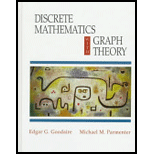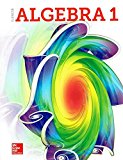
Discrete Mathematics with Graph Theory (Classic Version) (3rd Edition) (Pearson Modern Classics for Advanced Mathematics Series)
3rd Edition
ISBN: 9780134689555
Author: Edgar Goodaire, Michael Parmenter
Publisher: PEARSON
expand_more
expand_more
format_list_bulleted
Concept explainers
Textbook Question
Chapter 9.3, Problem 7TFQ
(Answers can be found in the back of the book.)
If graphs
Expert Solution & Answer
Want to see the full answer?
Check out a sample textbook solution
Chapter 9 Solutions
Discrete Mathematics with Graph Theory (Classic Version) (3rd Edition) (Pearson Modern Classics for Advanced Mathematics Series)
Ch. 9.1 - (Answers can be found in the back of the book.)
1....Ch. 9.1 - (Answers can be found in the back of the book.)
2....Ch. 9.1 - (Answers can be found in the back of the book.)...Ch. 9.1 - (Answers can be found in the back of the book.)...Ch. 9.1 - (Answers can be found in the back of the book.)
5....Ch. 9.1 - Prob. 6TFQCh. 9.1 - Prob. 7TFQCh. 9.1 - Prob. 8TFQCh. 9.1 - Prob. 9TFQCh. 9.1 - Prob. 10TFQ
Ch. 9.1 - 1. [BB](Fictitious) A recently discovered map of...Ch. 9.1 - Prob. 2ECh. 9.1 - 3. One of the owners of the houses in the Three...Ch. 9.1 - Prob. 4ECh. 9.1 - Prob. 5ECh. 9.1 - Prob. 6ECh. 9.1 - You and a friend meet three other couples at a...Ch. 9.1 - 8. (a) A graph has six vertices, every two of...Ch. 9.1 - [BB] A graph has six vertices, every two of which...Ch. 9.1 - Prob. 10ECh. 9.1 - Prob. 11ECh. 9.2 - Prob. 1TFQCh. 9.2 - Prob. 2TFQCh. 9.2 - Prob. 3TFQCh. 9.2 - (Answers can be found in the back of the book.) is...Ch. 9.2 - Prob. 5TFQCh. 9.2 - Prob. 6TFQCh. 9.2 - Prob. 7TFQCh. 9.2 - Prob. 8TFQCh. 9.2 - Prob. 9TFQCh. 9.2 - Prob. 10TFQCh. 9.2 - Prob. 1ECh. 9.2 - Prob. 2ECh. 9.2 - Prob. 3ECh. 9.2 - Prob. 4ECh. 9.2 - Prob. 5ECh. 9.2 - Prob. 6ECh. 9.2 - Prob. 7ECh. 9.2 - Draw a graph with 64 vertices representing the...Ch. 9.2 - Consider again the graph accompanying Exercise 5...Ch. 9.2 - Prob. 10ECh. 9.2 - Prob. 11ECh. 9.2 - Prob. 12ECh. 9.2 - 13. [BB] At most social functions, there is a lot...Ch. 9.2 - Prob. 14ECh. 9.2 - 15. [BB;(a)] for each pair of graphs shown,...Ch. 9.2 - Prob. 16ECh. 9.2 - Prob. 17ECh. 9.2 - For each of the following sequences, determine if...Ch. 9.2 - Prob. 19ECh. 9.2 - [BB] A graph has five vertices of degree 4 and two...Ch. 9.2 - Determine whether each of the graphs in Fig 9.23...Ch. 9.2 - Prob. 22ECh. 9.2 - Prob. 23ECh. 9.2 - 24. [BB](requires calculus) Prove that the number...Ch. 9.2 - Prob. 25ECh. 9.2 - Prob. 26ECh. 9.2 - Prob. 27ECh. 9.2 - Prob. 28ECh. 9.2 - Prob. 29ECh. 9.2 - Prob. 30ECh. 9.2 - Prob. 31ECh. 9.2 - Prob. 32ECh. 9.2 - Prob. 33ECh. 9.2 - Prob. 34ECh. 9.2 - Prob. 35ECh. 9.3 - (Answers can be found in the back of the book.) It...Ch. 9.3 - Prob. 2TFQCh. 9.3 - Prob. 3TFQCh. 9.3 - Prob. 4TFQCh. 9.3 - Prob. 5TFQCh. 9.3 - (Answers can be found in the back of the book.)
6....Ch. 9.3 - (Answers can be found in the back of the book.) If...Ch. 9.3 - Prob. 8TFQCh. 9.3 - Prob. 9TFQCh. 9.3 - Prob. 10TFQCh. 9.3 - [BB] For each of the ten pairs of graphs that can...Ch. 9.3 - Prob. 2ECh. 9.3 - [BB] Draw all nonisomorphic graphs on n =3...Ch. 9.3 - [BB;(b)] for each pair of grpahs shown. If the...Ch. 9.3 - Prob. 5ECh. 9.3 - Prob. 6ECh. 9.3 - Prob. 7ECh. 9.3 - [BB] Prove that two graphs that are isomorphic...Ch. 9.3 - Consider the following three graphs. [BB] How many...Ch. 9.3 - Prob. 10ECh. 9.3 - Prob. 11ECh. 9 - 1. In the Konigsberg Bridge Problem, a tragic fire...Ch. 9 - 2. (a) Draw a configuration of four houses and two...Ch. 9 - 3. Find the solutions, where possible, for the...Ch. 9 - Draw a graph with six vertices at least three of...Ch. 9 - For each of the following sequences, determine if...Ch. 9 - 6. (a) Does there exist a graph with degree...Ch. 9 - Determine whether or not each of the following...Ch. 9 - Answer these questions for each sequence: Does...Ch. 9 - Find a necessary and sufficient condition for the...Ch. 9 - Prob. 10RECh. 9 - Suppose a graph has 49 vertices, each of degree 4...Ch. 9 - Prob. 12RECh. 9 - A graph G has 50 edges, four vertices of degree 2,...Ch. 9 - Prob. 14RECh. 9 - For each pair of graphs shown in fig 9.30 If the...Ch. 9 - Prob. 16RECh. 9 - 17. For each of the following cases, explain why...Ch. 9 - George is examining three graphs G1, G2, G3. He...Ch. 9 - Answer Exercise 18 again, assuming that Georges...Ch. 9 - Prob. 20RE
Knowledge Booster
Learn more about
Need a deep-dive on the concept behind this application? Look no further. Learn more about this topic, subject and related others by exploring similar questions and additional content below.Similar questions
Recommended textbooks for you
 Algebra & Trigonometry with Analytic GeometryAlgebraISBN:9781133382119Author:SwokowskiPublisher:Cengage
Algebra & Trigonometry with Analytic GeometryAlgebraISBN:9781133382119Author:SwokowskiPublisher:Cengage College Algebra (MindTap Course List)AlgebraISBN:9781305652231Author:R. David Gustafson, Jeff HughesPublisher:Cengage Learning
College Algebra (MindTap Course List)AlgebraISBN:9781305652231Author:R. David Gustafson, Jeff HughesPublisher:Cengage Learning Glencoe Algebra 1, Student Edition, 9780079039897...AlgebraISBN:9780079039897Author:CarterPublisher:McGraw Hill
Glencoe Algebra 1, Student Edition, 9780079039897...AlgebraISBN:9780079039897Author:CarterPublisher:McGraw Hill


Algebra & Trigonometry with Analytic Geometry
Algebra
ISBN:9781133382119
Author:Swokowski
Publisher:Cengage

College Algebra (MindTap Course List)
Algebra
ISBN:9781305652231
Author:R. David Gustafson, Jeff Hughes
Publisher:Cengage Learning

Glencoe Algebra 1, Student Edition, 9780079039897...
Algebra
ISBN:9780079039897
Author:Carter
Publisher:McGraw Hill
Sequences and Series Introduction; Author: Mario's Math Tutoring;https://www.youtube.com/watch?v=m5Yn4BdpOV0;License: Standard YouTube License, CC-BY
Introduction to sequences; Author: Dr. Trefor Bazett;https://www.youtube.com/watch?v=VG9ft4_dK24;License: Standard YouTube License, CC-BY